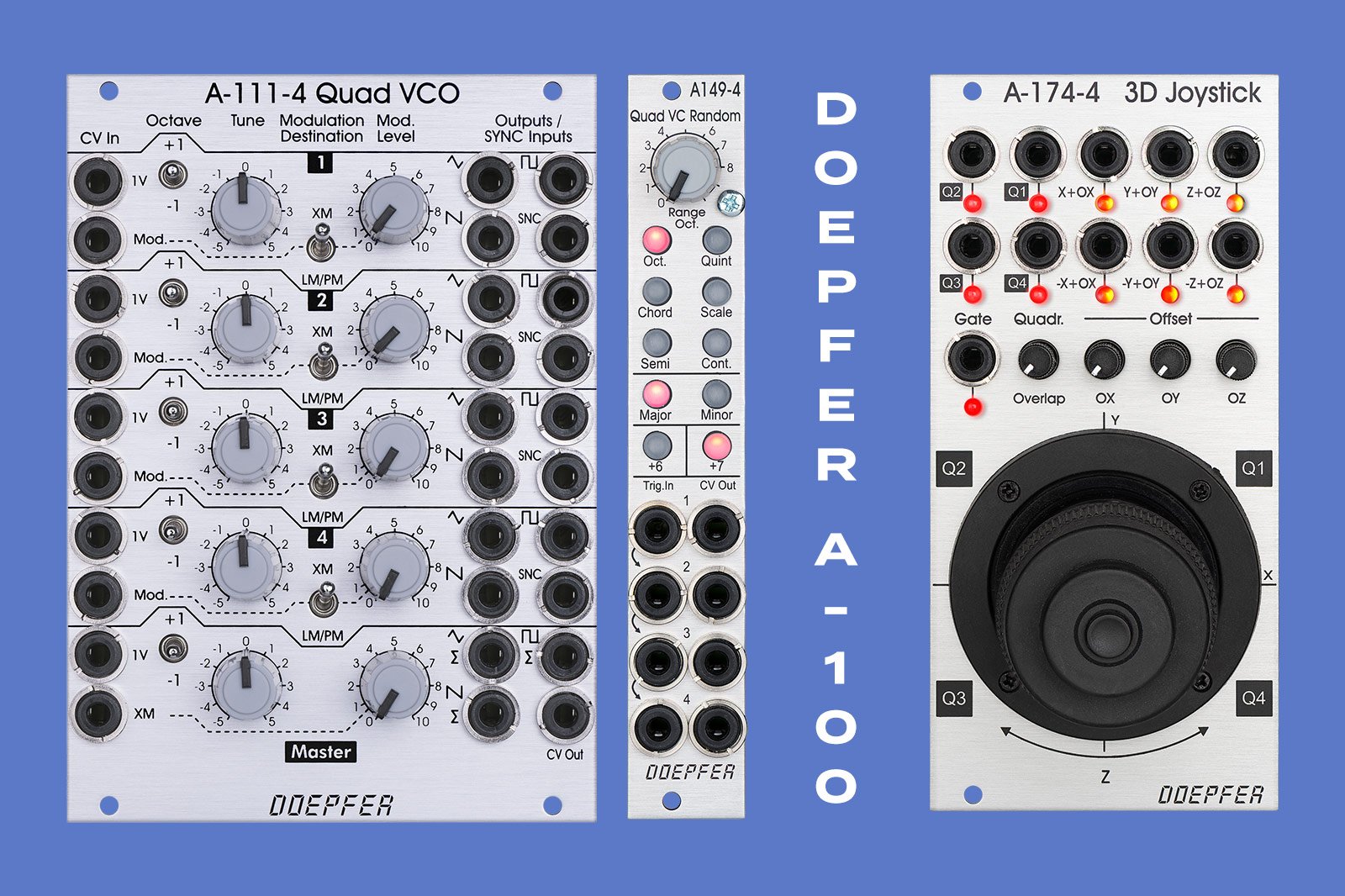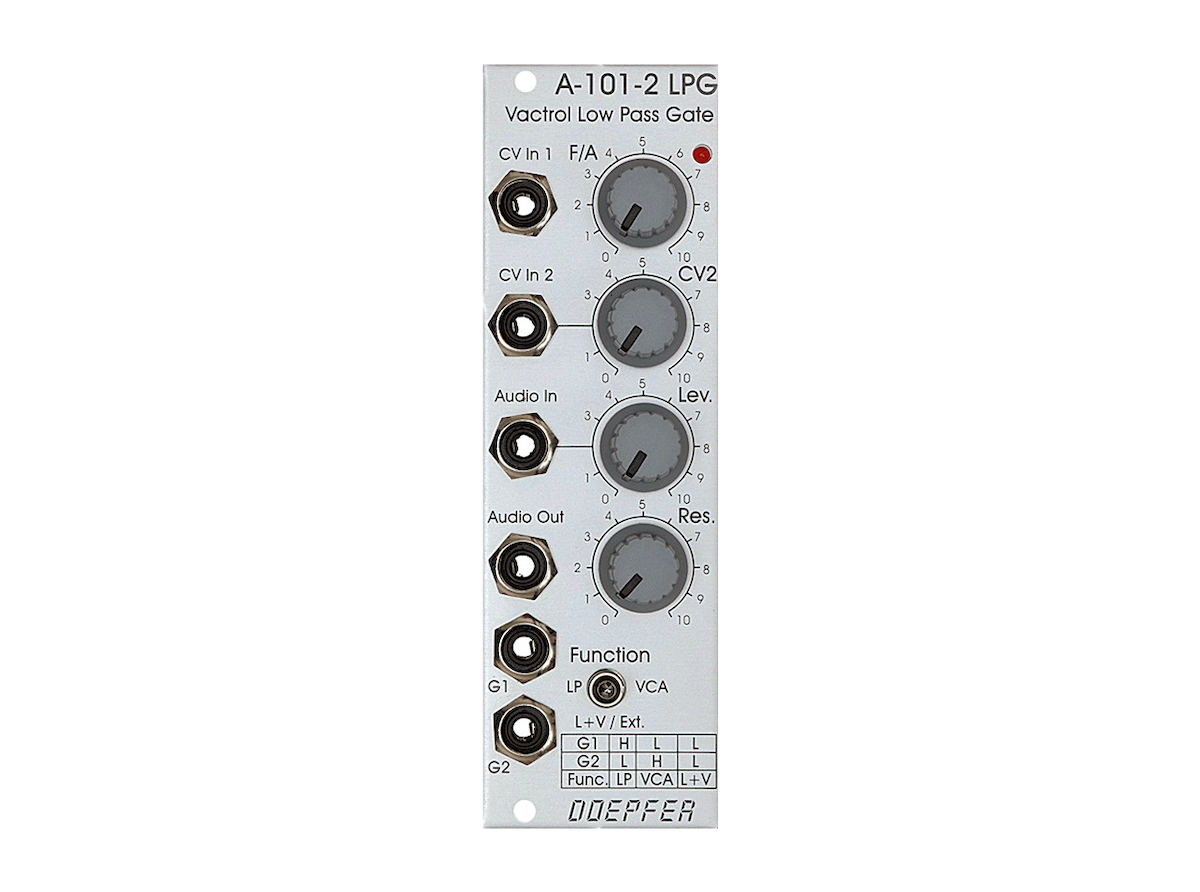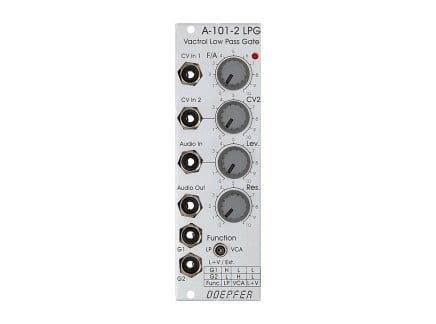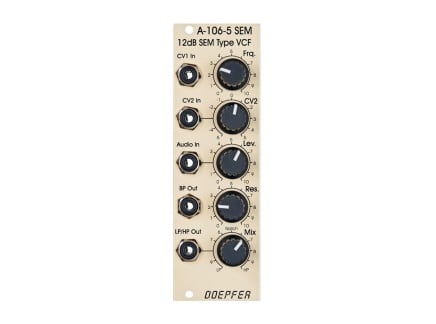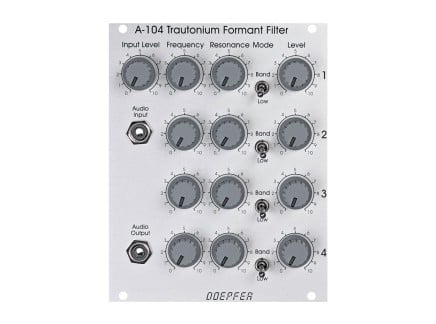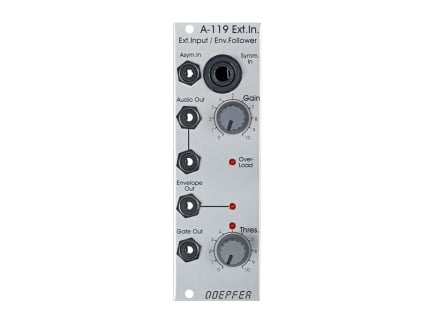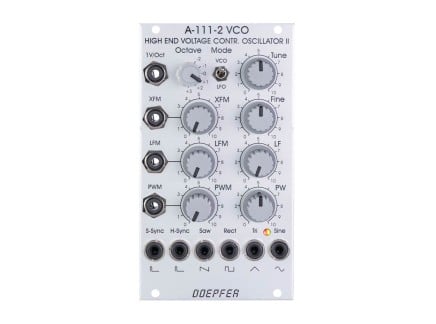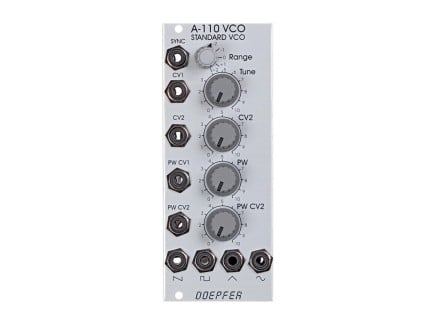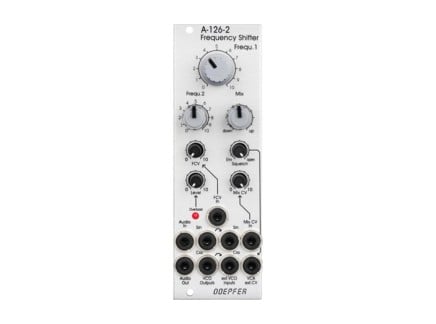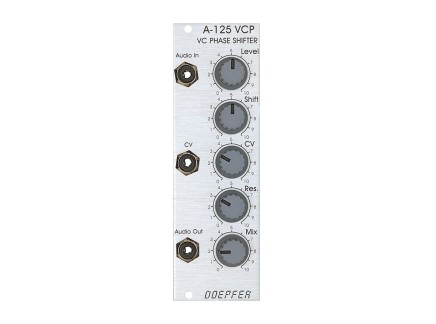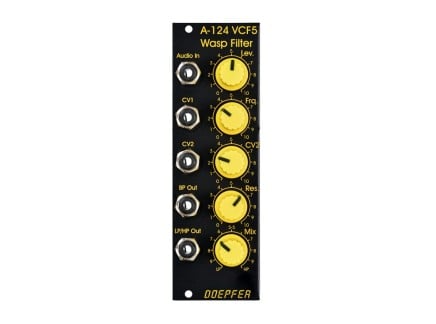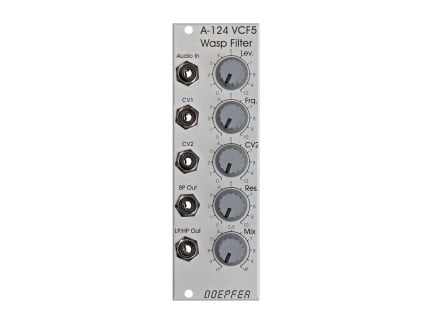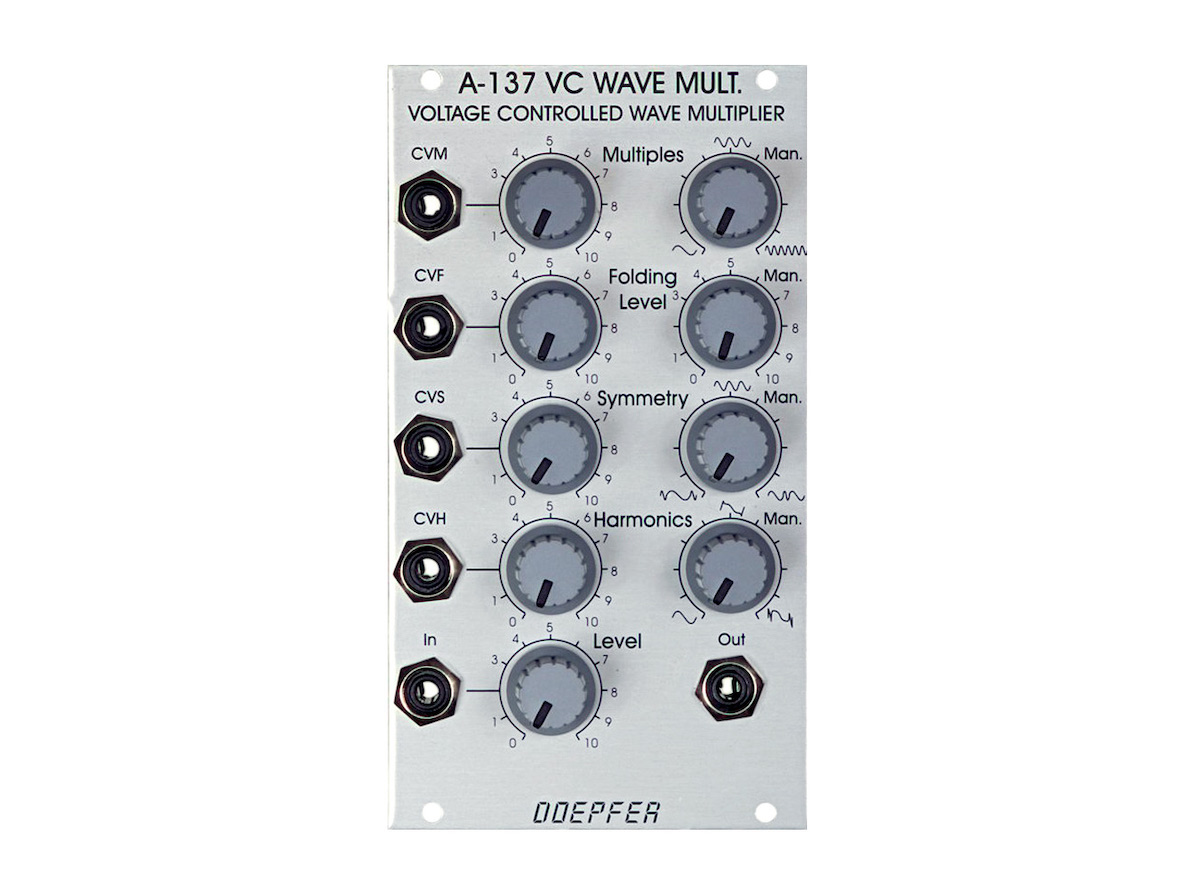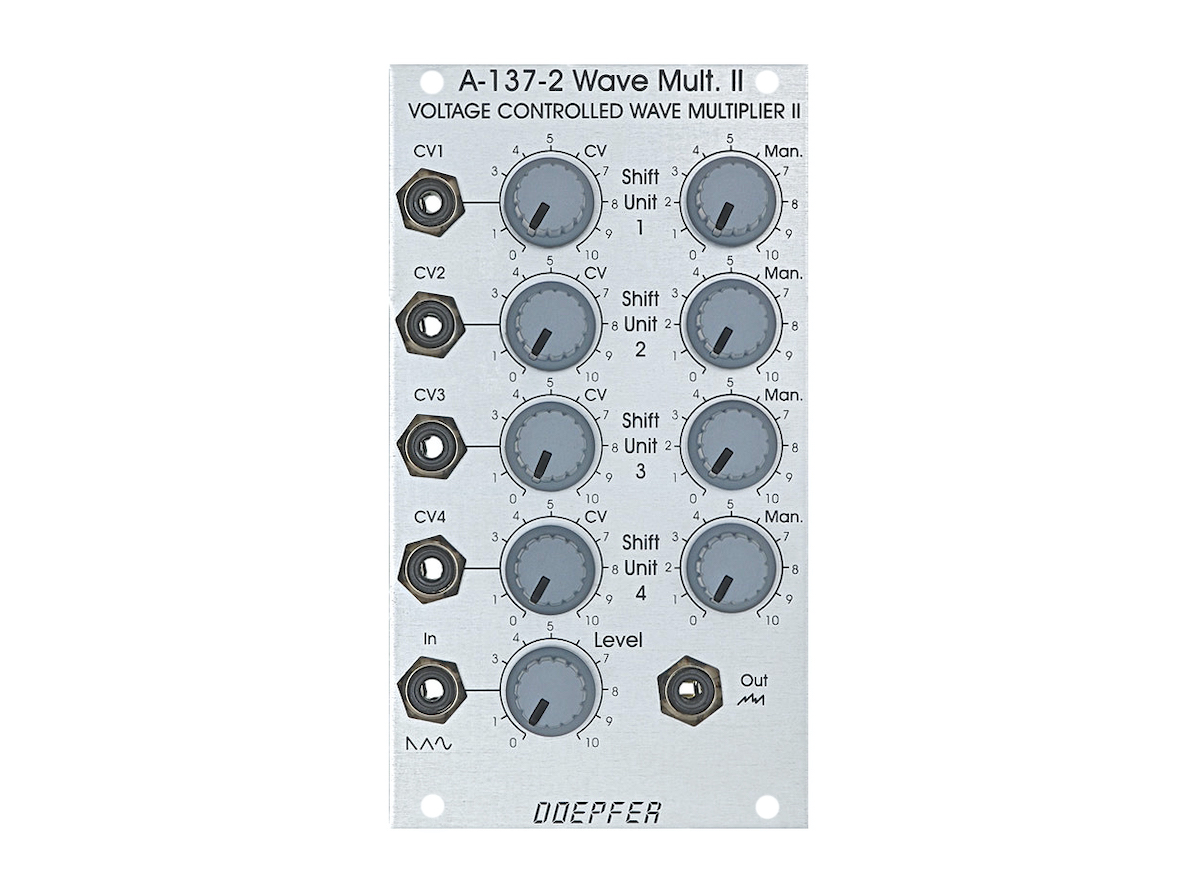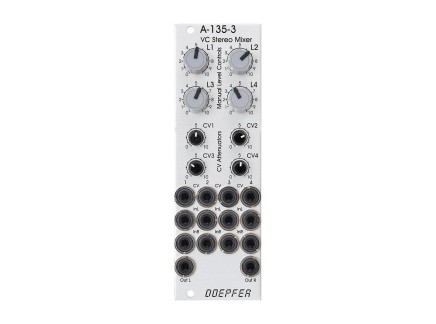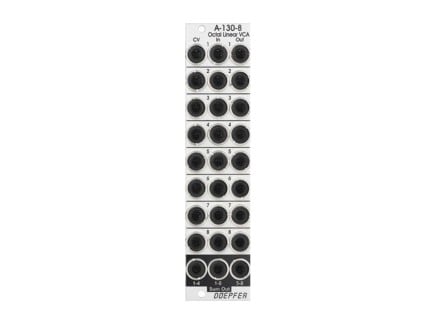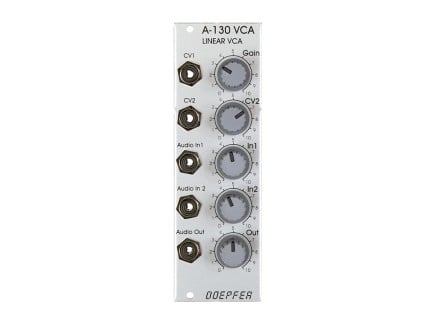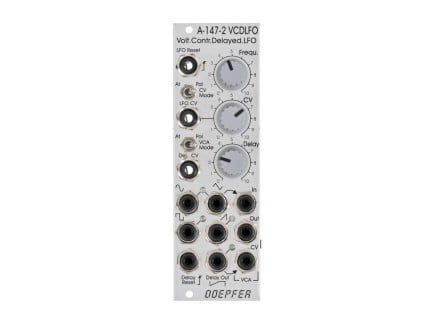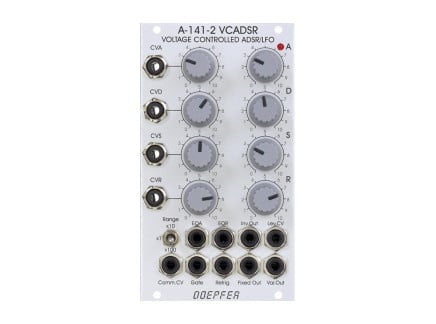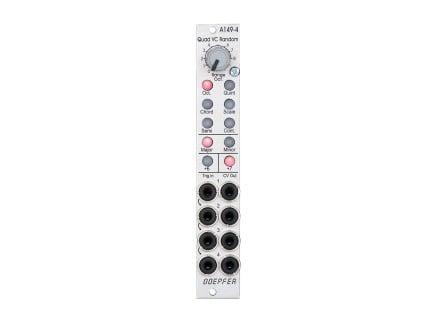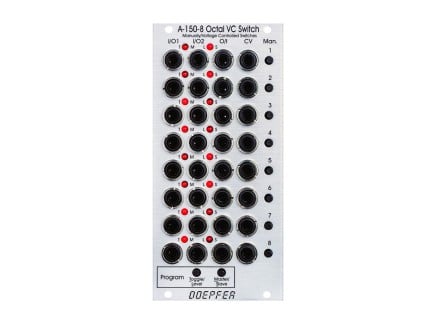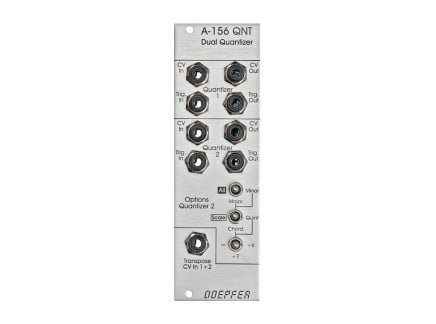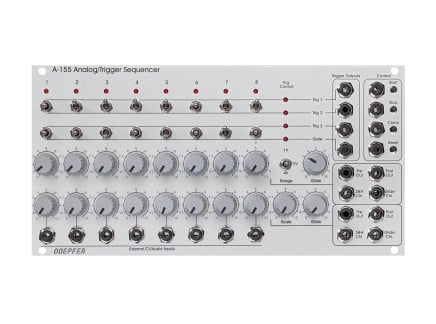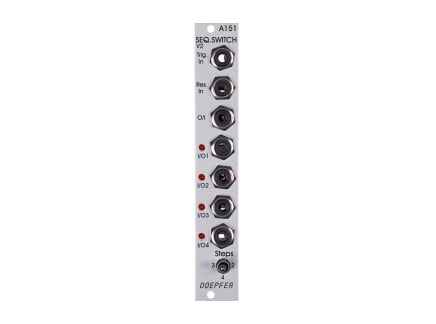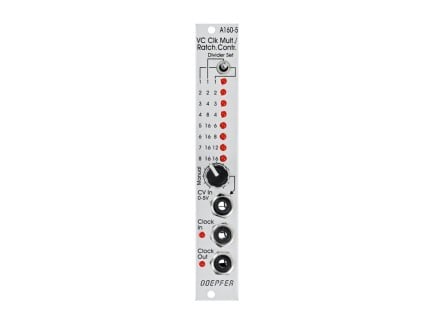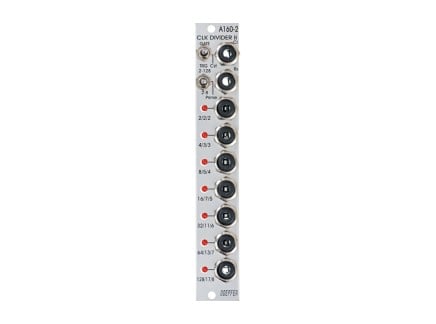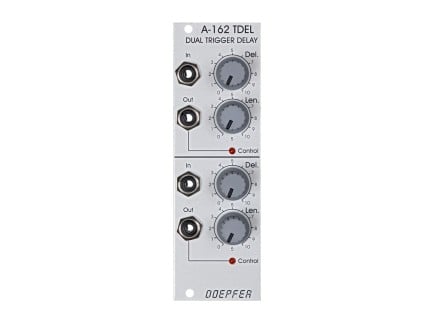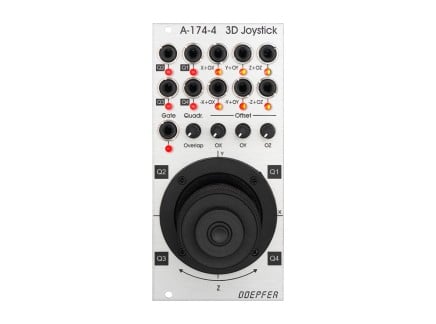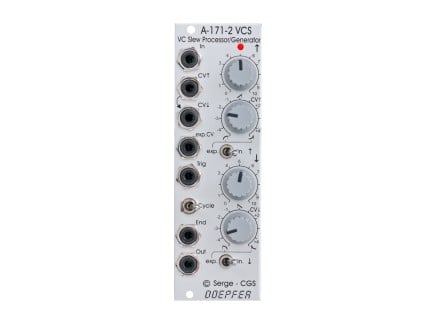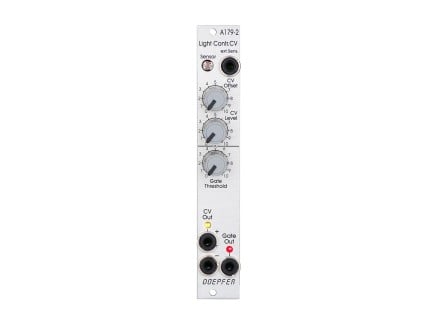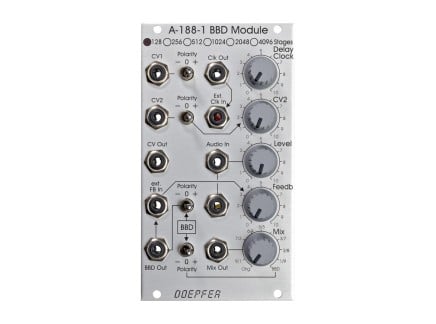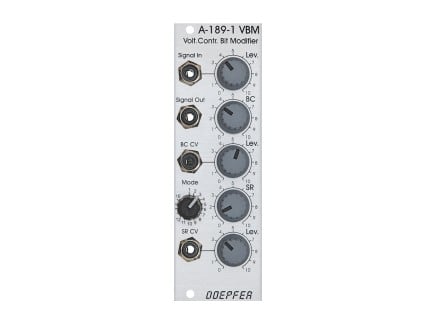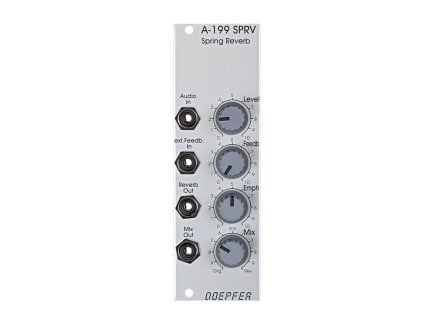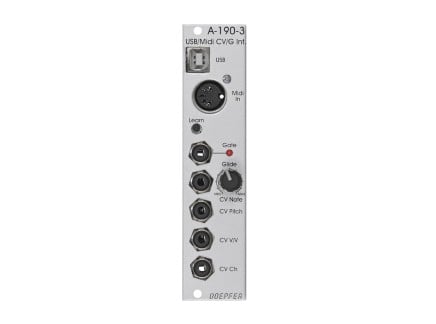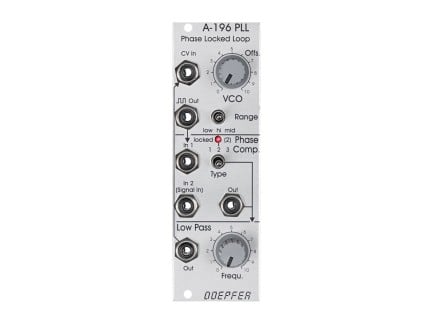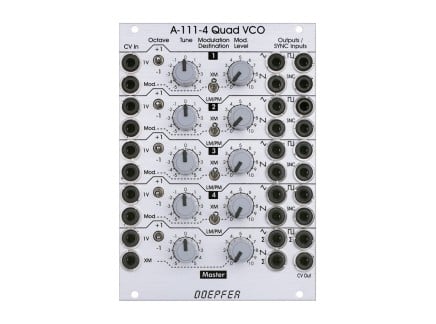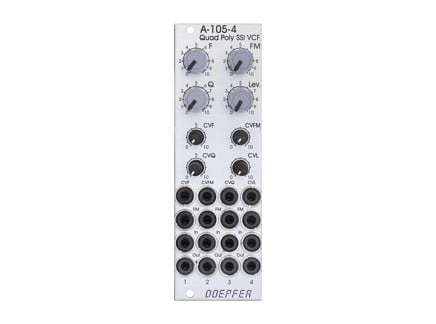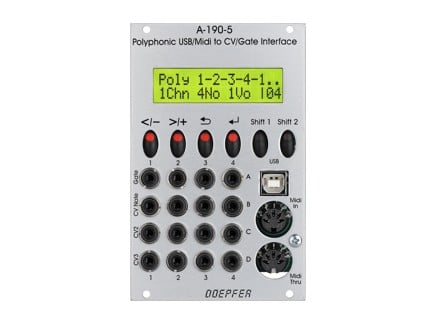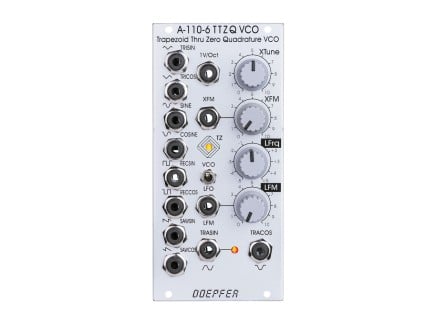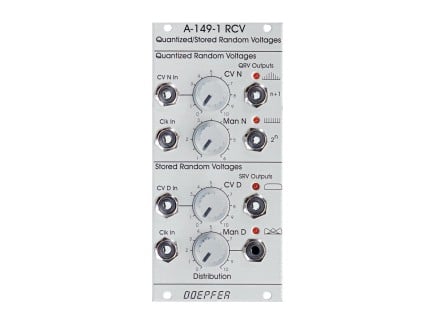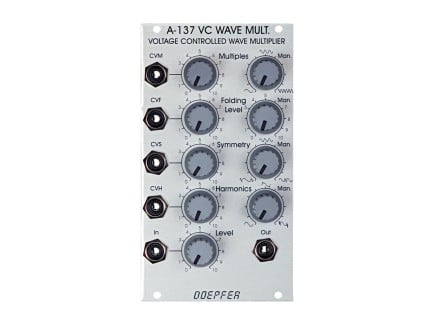In the current day of the readily available modular synthesizer, it is easy to forget that these inspiring tools were not always available to the average synth enthusiast and musician. Sure, the 1990s saw the arrival of tons of innovative digital technology—but the hulking behemoths of modulars past were not available to most. Most modular synthesizers had been out of production for decades; and for those that remained, they were simply too large, too expensive, too complex, or too home-made to be a tenable option for those looking to make music without a major label budget and major label recording space. Most people could not imagine finding a home for the futuristic space stations of knobs and jacks that took up entire walls...but man...they looked cool, eh?
German synth maker Dieter Doepfer saw room to remedy the issue and to put these inspiring tools into the hands of the working musician. He wanted to make a modular synthesizer that was both more affordable and more portable than what came before. Eventually, Eurorack—the format emerging from his creations—would go on to become the most popular modular synthesizer format by a landslide. In the current day, it still is.
The original A-100 synthesizer consisted of approximately 10 modules that created the simple building blocks the user would need to actually make music. Today, there are well over 100 modules in the A-100 system, so we wanted to take a minute to break down some of the current offerings from the originator of Eurorack.
The modules in the A-100 system are grouped by function—and their module numbers reflect their general purpose. For example, the A-11Xs are sound sources, whereas the A-14Xs are modulation sources. Though it's probably not necessary to know all of the individual numbers in the A-100 system...knowledge of the groupings can certainly help find the module one needs. That in mind, let's take a quick look at each module type in the A-100 series, pointing out a few highlights from each group.
A-10X: Filters and Effects
The A-10Xs include a wide assortment of filter modules and a couple of phase shifters. The modules in this section are mainly intended to add (or subtract) sonic color from the sound sources contained in the rest of the system. A handful of them are based on older designs from other manufacturers, updated by Doepfer for use in the Eurorack format. Here are some of our favorites.
A-101-2 Vactrol Low Pass Gate: The Vactrol-based low pass gate is a modular classic a la Don Buchla. Low Pass Gates combine low-pass filter and a VCA behavior in a single module. Typically, the element responsible for the classically plucky sound is a opto-isolator, generically known as a Vactrol. The Vactrol is "plucked" by a trigger or gate and the natural sounding decay of the Vactrol makes a very convincing drum or "bongo." Interesting to note: The decay of each Vactrol is different, and thus each unit will vary to some degree.
The module includes a switch to select between low-pass, VCA, or both modes. The separate gate inputs, control over resonance and the dual CV inputs make for plenty of available tonal possibilities. Snappy!
A-104 Trautonium Formant Filter: A Formant filter is one that uses multiple parallel filters, usually in order to create vowel-like sounds resembling a human voice. This particular formant filter is based on the Mixtur Trautonium, an early German electronic instrument that was actually used by Oscar Sala (among other things) to create the bird sounds in Alfred Hitchcock's The Birds. How neat is that?!?
The module has one input and one output and controls for Level, Frequency, and Resonance for each of its four filters. Each filter also has a switch for BP or LP mode for more variation. Doepfer mentions on their website that the filter input is sensitive to distortion.
A-106-5 -12db SEM VCF: The A-106-5 is a module based off of the classic Oberheim SEM filter. It has an output for bandpass and a second output for both LP and HP. The second output has a dedicated control pot for the response type. It rolls from LP on the left to HP on the right. However, about halfway between the two you’ll find a Notch filter response. Pretty rad. Though it won't self-oscillate, once this beasty goes above halfway on the level knob...things get a whole lot dirtier!
A-11X: Sound Sources/Processors
The A-11Xs are where we find the bulk of the Doepfer oscillators and sound sources. This section also contains things like noise generators or waveshapers to take that basic oscillator sound and begin from a slightly different place than a simple waveform. Hence, the inclusion of the input module to inject an external sound into the system.
A-110-1 Standard VCO: The Doepfer A-110-1 is a bread and butter analog sawtooth-core oscillator, with all the sonic options you'd expect. The module has outputs for Saw, Square, Triangle and Sine waveforms. Though not harmonically pure, the triangle and sine waves have a little extra character to them than the standard ones produced by a triangle core oscillator.
The five-octave switch is also a nice touch. It makes for a fun bit of performative movement with the little flick of the switch. To top it off, the Standard VCO has a handy hard sync input for more biting tones and not one…but two Pulse Width Modulation inputs. I mean...why not?
A-111-2 High End VCO II / LFO: The A-111-2 tracks over an impressive 10 octaves and has a 15 octave range (what???). Careful not to set off the neighborhood dogs with this one! The A-111-2 is a triangle core oscillator as opposed to the A-110-1—so those triangle and sine waveforms are a bit more precise and clean. The A-111-2 features both linear and exponential FM inputs along with both hard and soft sync inputs so the tonal timbral range is greater than on the A-110-1.
A-119 External Input / Envelope Follower: One of the more exciting realizations in synthesis is that we can control our synthesizers with nearly any sound if the synthesizer is equipped to do so. Sure, the A-119 can get external signals into the system to use as actual audio (courtesy of the integrated preamp, great for mic, instrument, or line-level signals)—but it also creates a control voltage signal from the audio being sent in.
Take that annoying construction noise outside, mic it up, and turn it into something useful for once! The A-119 spits out a control signal based on the amplitude of the audio being sent in. Additionally, it can produce gates once that amplitude crosses a set threshold...making it a great way to extract control from external audio signals.
A-12X: Even More Filters and Effects
The A-12Xs are more of the same style modules as the 10xs. Of note, is that this section contains frequency shifting modules and the (regrettably discontinued) Vocoder subsystem. So, though quite similar to the A-10X modules, many of the A-12X modules take on a somewhat more esoteric approach to sound manipulation.
A-124 VCF5 Wasp Filter: Based on the filter circuit from the rare EDP Wasp synthesizer, the A-124 looks fairly similar to the Doepfer SEM filter mentioned above. However, this little beasty has a bit of extra sting. Doepfer mentions on their site "this design 'abuses' digital inverters as analog operational amplifiers leading to distortions and other 'dirty' effects that generate the specific sound of this filter." The Wasp filter is in its own unstable little world in terms of Eurorack filters, and certainly adds spice to any patch. It's truly a highlight in the A-100 series as a whole.
A-125 Voltage Controlled Phase Shifter: The phaser is recognizable to many musicians as a '70s guitar effect, but in the context of a modular synth, the effect is a different thing altogether. The subtle movement derived from a phase shifter is very handy for making something static sound less static. Throw a stereo pair on a pad sound and it’s pure atmospheric bliss. Or, on simple drum triggers, resonant phasers can create weird liquidy sputters that rip through a mix when pushed. To get technical for a moment...phase shifting here is derived from dynamic comb filtering.
From Doepfer: "The comb filtering produces a series of gaps in the audio spectrum by the canceling process which is created by having identical sounds 180° out of phase with each other."
A-126-2 Frequency Shifter: A much less common effect altogether, the Doepfer Frequency Shifter is a very cool module that works well in a feedback path (or on its own) to create absolute sonic madness. First, let's note the difference between pitch and frequency shifting…
A pitch shifter retains the mathematical harmonic relationship between the overtones of the original sound and the shifted sound regardless of what the initial pitch is. So if the pitch is being multiplied by 1.5 to get to the shifted pitch…it will always multiply by 1.5 if all controls are the same. 1000Hz will shift to 1500Hz (a 500Hz difference) where 2000Hz will shift to 3000Hz (a 1000hz difference). As you can see, the numerical amount the pitch is shifting is actually more in the higher pitched scenario.
A frequency shifter on the other hand is simply adding an amount set by the user to the initial pitch. If it is set to add 500hz then it will add 500hz regardless of what the pitch is. This has peculiar implications, since it shifts all overtones by the same number of Hertz—so, the more shift you apply, the more the sound's overtone spectrum gets, well, sort of wrecked. It sound somewhat like ring modulation; but in any case, for more on this topic's history and potential uses, be sure to check out this article all about frequency shifters.
Similar to the classic Buchla 285, the Doepfer Frequency shifter shifts both up and down at the same time. This allows for some very complex tonal soundscapes when mixed together after the output. The A-126-2 cleverly adds a VCA to the shifted signal, thus allowing you to CV not only the pitch of the signal but the wet/dry blend as well.
A-13X: VCAs, Mixers, & Modifiers
The A-13X series consists of VCAs, panners, mixers, and basically the bulk of the amplitude-based modifiers in the A-100 series. These modules are like having a bunch of hands on a bunch of volume knobs…turning things up and down as needed throughout the patch, or otherwise altering your waveforms based on their current amplitude.
A-130 Linear VCA: The A-130 is a straightforward, affordable linear VCA that does its job well. The module is DC-coupled, so it will work with both audio and control voltage signals—and it can also be used as a simple two channel mixer in a pinch. The two audio inputs are kind of unique in the world of simple VCAs.
A-130-8 Octal Linear VCA: Rejoice! You’ll never not have enough VCAs again. Boasting the fewest possible knobs of any module, the Octal Linear VCA has eight linear VCAs in one tidy package. At the bottom of the module are 3 mixed outputs. Each VCA contains an input, a CV in, and an Output. Simple...effective...and unmistakably Doepfer.
A-135-3 VC Stereo Mixer: Another no frills but packed offering from Doepfer is the A-135-3 VC Stereo Mixer, which offers four channels of stereo mixing in 8hp. Here, there are four stereo ins and voltage control over the level of each channel. It's packed, but super handy.
Editor's Note: Doepfer Wave Multipliers Hiding among the mostly utilitarian A-13X modules are two of Doepfer's most peculiar modules altogether: the A-137-1 Wave Multiplier I and A-137-2 Wave Multiplier II. These have long been a part of the Doepfer lineup, providing all manner of distortions and sonic colorations. A-137-1 is a complex wavefolder inspired by classic designs by Buchla and Serge; A-137-2, however, combines multiple phase-shifted copies of a single signal to create animated, mangled versions of the input. These are certainly some of Doepfer's strangest offerings, and they're also some of the most special.
A-14X: Modulation Sources
The A-14Xs are where we find our envelopes and LFOs along with some random sources. These are the modules that tell our VCAs when to open and our oscillators how to wobble. These modules are the blood flowing throughout the circulatory system of our modular system.
A-141-2 Voltage Controlled Envelope Generator: For most applications in modular, a simple two-stage envelope will do the trick just fine. However, for those who like to interact with a keyboard...the A-141-2 has you more than covered. Voltage control over each stage is just the beginning. Patch the inverted output back into the CV inputs and you get an exponential response. The A-141-2 also has master envelope level CV to add some velocity sensitivity for maximum expressiveness per key press.
A-147-2 Voltage Controlled Delayed LFO: Through the combination of an LFO under voltage control, a VCA, and a delay under voltage control, the A-147-2 is another very thoughtful module that allows for expressive movement in a patch that would otherwise require a number of different modules. Now, obviously you don't need delayed tremolo on every patch (or maybe you do!?!?), but in a pinch, the Delayed LFO can be used for its individual parts as well.
A-149-4 Quad Random Voltage Source: The Doepfer A-149-4 offers four simultaneous outputs that arrive in the form of both quantized and unquantized voltages. The neat thing about the A-149-4 is that the module allows for very quick musical patches based around musical intervals. The quantized voltages here can be tuned to the interval you choose. The trigger inputs are normalled as well, so in practice you often only need one to trigger all four outputs. It's a 4 hp happy accident machine.
A-15X: Switches and Sequencers
The A-15Xs are where we find our time-based programmers and the modules that clean those up a bit. Sequencers, switches, and quantizers are there to allow us to make music with a progression of notes and beats, and to dial in those notes accurately with some semblance of melodic form.
A-150-8 Octal Manual / Voltage Controlled Programmable Switches: Voltage controlled switches can add tons of variation to a patch. As the name suggests, the A-150-8 contains eight switches that can be operated manually or under voltage control. As a simple use, send in two different sequences and switch between them on one switch. With eight of these, there is a lot of possibility to keep a patch moving.
A-155 Analog/Trigger Sequencer: The A-155 is an extremely playable sequencer laid out with room for each individual step to be adjusted without the use of menus or button combos. The triggers are directed to the outputs via switches that can be flipped to quickly change things up on the fly. The addition of the external signal inputs per step on the bottom row of CV sequencing is incredibly fun, and allows for wild variations on what would normally be just an 8 step sequence.
A-156 Dual Quantizer: The A-156 will serve a much-needed role in the Doepfer ecosystem of analog sequencers. Since some of the fun of the A-155 is that it's so quick to alter the sequence, it's very easy to get off track in a more melodic piece of music. The A-156 will pull those stray pitches back into the scale you set on the module. Or, for a fun bit of modular wizardry, try only quantizing when you choose by sending in a trigger.
Editor's Note: The Humble A-151: The Doepfer A-151, though unassuming, is easily one of their best-selling modules of all time. This simple module is a 4-to-1 or 1-to-4 sequential switch, designed to allow you to select between multiple sources or destinations in order simply by sending in a single trigger. Thinking back over a decade, the A-151 really gained popularity after the introduction of Make Noise's Pressure Points + Brains sequencing system. By sending the three rows out of Pressure Points into three of A-151's inputs and triggering the A-151 once per cycle through the sequence, you can achieve complex 24-step sequences from what would otherwise only be an eight-step sequencer. It's a classic modular patch trick, and A-151 makes it possibe (along with many, many other clever patch ideas).
A-16X: Clock / Gate / Digital Logic Modules
The A-16Xs are modules based around clock or gate signals and ways to modify or control them. Here we have the dividers and multipliers that allow us to create mathematical relationships between one clock signal and another. This section also contains the logic based modules which allow us to use two signals to create a third.
A-160-2 Clock / Trigger Divider II: The A-160-2 takes a clock or trigger stream and divides it by an amount based on the switches at the top of the module and the output jack chosen. It divides starting from half the frequency of the original stream down to 1/128 of that stream. The switches at the top, which determine how things are divided, allow for a decent amount of deviation from the standard division of the earlier A-160-1.
A-160-5 Voltage Controlled Clock Multiplier / Ratcheting Controller: The A-160-5 multiplies clock streams, thus allowing for the creation of ratchets and other interesting rhythmic effects. The VC Clock multiplier will multiply based on the CV amount sent into the CV jack.
Important to note: The A-160-5 will take a couple clicks of the clock to stabilize, simply because of the nature of how a clock multiplier works.
A-162 Dual Trigger Delay Get off the grid man! The A-162 allows for the rigid timing of quantized triggers to loosen up a bit. Though it’s important to have the components of a rhythm track tight enough to hold together...it can be equally important to have them not feel so rigid so as to get boring or repetitive. The A-162 accomplishes this by taking a track of triggers and delaying its onset by an amount set on the front panel.
Of course, this can also be handy for resolving slight timing issues in your system—ensuring that everything lines up exactly the way that you want it.
A-17X: Voltage Processors & Voltage Sources
The A-17Xs contain a multitude of all purpose voltage sources or processors. Here we find things like voltage inverters and slew limiters, but also controller-based modules like mod wheels or keyboards. The A-17Xs let us get hands-on with our system.
A-171-2 Voltage Controlled Slew Processor / Generator: The A-171-2 is one of those modules that can be a lot of different things based on how you patch it. It's based on the cult classic Dual Universal Slope Generator, originally created by Serge Tcherepnin for the 1970s Serge Modular Music System; but rather than offering two channels of processing, the A-171-2 is a single-channel slope generator.
Obviously, it can be a slew processor, but it can also be an LFO, a triggered envelope, a LPG, a subharmonic generator, or a trigger delay. There is certainly a place for the A-171-2 in nearly any patch—you'll find that it can provide similar results to a single channel of Make Noise's Maths and other Serge-derived designs.
A-174-4 3D Joystick: The Doepfer A-174-4 and its joystick are reminiscent of '80s and '90s arcade games—and it actually works in three dimensions as opposed to the standard 2. The joystick has the standard X and Y axis but also has a unique rotating ring on the top to add a Z "dimension." Additionally, the tip of the joystick has a button for sending out gates at will. Pretty rad.
A-179-2 Light-Controlled CV/Gate Source: The A-179-2 can actually be seen as the photosensitive relative of the A-119. The module takes an input signal and converts that into voltage and a gate based on a set threshold. This time however, that input signal is light rather than external audio! Use for generative control from your environment, or bring along your flashlight for performative effects.
A-18X: Auxiliary Modules / Modifiers / Effects
The bulk of the rest of the effect modules are found in the A-18X range. Delays, bit crushers, and even the multi effect (A-187-1) are found here. It seems that Doepfer also puts some of the other modules that don't quite fit into other categories here. For example: CV buffers, Mults, or USB-based modules are found here as well.
A-184-1 Ring Modulator / S&H / T&H / Slew Limiter: Packed with functionality in just 4hp, the A-184-1 handles simple versions of three important functions. It's essentially a combination of three different modules: a ring modulator, a Sample & Hold/Track & Hold, and a slew limiter. These aren’t the most complex versions of these functions, but sometimes all you need is a little spice—and this module can add a lot to a small system.
A-188-1 BBD Delays: The term "Bucket Brigade" comes from the idea of passing buckets of water from one person to another down a long line. The A-188-1 uses a bucket brigade device, a special electronic circuit based on this concept, in order to create a range of effects. Flange, chorus, simple delays and of course Karplus-Strong Synthesis are all attainable here. One interesting feature of the Doepfer A-188-1 modules is the decision to operate way outside of the normal range of clocking for BBD delays. This creates a more experimental delay capable of getting very strange on the extreme ends of the clocking spectrum—introducing all sorts of peculiar high-frequency noise, pseudo-bitcrushing, and more.
It's worth noting that the A-188-1 is available in several distinct versions, based on the number of delay stages available (from 128 stages at the shortest to a whopping 4096 stages). Generally speaking, the smaller the number of stages, the better-suited the module will be for Karplus-Strong, flanging, and comb filtering. The higher the number of stages, the longer the delay time range—making the modules better-suited for traditional delay/echo effects.
A-189-1 VC Bit Modifier / Bit Cruncher: The A-189-1 is a little beast of a bit crushing module with a selector switch that selects one of 16 different modes of operation. A second control and CV input for sample rate reduction is also included, thus allowing for quite a bit of variation in how the module sounds (hint: it's pretty devastating).
A-19X: Interfaces and Special Modules
The final section (A-19X) contains a multitude of MIDI-based modules and some oddball outliers. If the aim is to Interface modular with external gear, the A-19Xs are where to look. The outlier modules contained here include spring reverb, a PLL module, a ribbon controller, and a scope. It's worth a browse through the 18xs and 19xs to find that secret gem you didn’t know existed in Doepferland.
A-190-3 USB / MIDI-to-CV / Gate Interface: Perhaps the simplest of Doepfer's MIDI to CV modules, the A-190-3 does the job of allowing external MIDI gear to control your Eurorack. MIDI is sent into the module, and then back out on the output jacks for MIDI note, pitch bend, velocity, & finally an assignable CC. Additionally, the A-190-3 has an internal glide jack and knob that can be applied to the note CV output for creating portamento/glide effects.
A-196 Phase Locked Loop: A phase locked loop works by locking the phase of one input waveform to the phase of another. The A-196 consists of a VCO, a phase comparator, and a Low Pass Filter in sequence. The internal VCO is used as one of the input sources—and you add the other. The phase comparator section locks the internal oscillator to the phase of what you insert into "in 2," and that is then sent to the filter section. The Filter section is then fed back to the beginning cv input at the top thus creating the "loop" portion of the module. The A-196 is perfect for those looking for a different sort of “sync” sound than the standard "sync" inputs on an oscillator. Often, this results in gnarly, unstable tones; plus, the lowpass output can create a crude pitch-to-CV style voltage.
Fun test: try sending the PLL sounds that it can't quite figure out how to track. This yields enjoyably odd results.
A-199 Spring Reverb: The A-199 is not the most fully featured spring reverb in Eurorack, but it has that springy vintage something that has allowed spring reverb to endure for so long. The addition of the feedback loop is a nice touch, allowing for all sorts of experimentation with other effects inside the loop of the reverb itself (hint: try pairing with the A-126-2 Frequency Shifter into the feedback loop!). The emphasis knob will allow you to tonally color the output of the overall sound, and is very handy when using the feedback feature.
Bonus Round: Polyphony
In recent years, the Eurorack ecosystem has seen an influx of desire for more easily-attainable polyphony. Normally, in order to do this, a synthesist would lock up just about their entire system to make one sound. This was due to the nature of needing so many of all of the functions required to make a single voice. For example, a four-note chord would need four oscillators, four VCAs, four envelopes, and so on.
Doepfer has taken a crack at making this more efficient in terms of both space and cost by releasing a group of polyphonic modules. A number of these even come in the smaller form factor of the miniaturized modules Doepfer has released in recent years.
Examples of these smaller poly modules includes...
When paired with the other Doepfer poly modules such as the A-111-4 Quad Precision VCO and a MIDI to CV converter like the A-190-5 Poly MIDI/USB-to-CV/Gate Interface, polyphony is suddenly within reach. Perhaps the craziest part is that it only took 6 modules. Thanks Dieter!
To the future!

[Above: Dieter Doepfer at the A-100 System at Superbooth 2023]
From 10 modules to well over 100, the Doepfer A-100 has certainly evolved and grown over the years—over 25 years, in fact. What began from a desire to create a more affordable and portable modular system has developed into one of the most diverse and all encompassing ecosystems in Eurorack. Put simply, one could decide to use only Doepfer modules and have an incredibly thorough system capable of creating a lifetime of music.
The current focus on polyphonic modules begs the question: "Where to next?" Affordable polyphony in modular synthesis was a thing of fiction in the past...but here we are. So, then...where to next?

